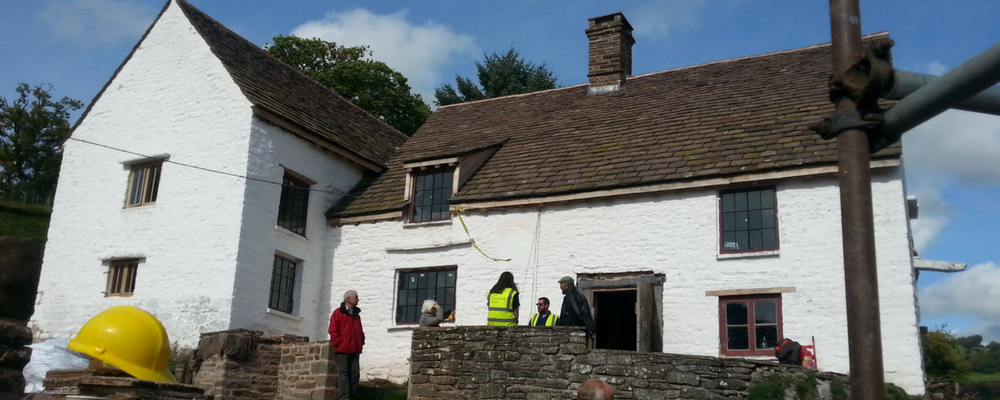 From the outside at least, Llwyn Celyn is at last starting to look habitable, as visitors explored it on our recent open day for locals.
From the outside at least, Llwyn Celyn is at last starting to look habitable, as visitors explored it on our recent open day for locals.
A date for Llwyn Celyn
Landmark has been involved with the site at Llwyn Celyn for more than a decade, so you would have thought by now that we had discovered all there was to know. But yet again, a Landmark project has kept its best secrets almost till last, only yielding them up when restoration works are very well underway. Two amazing pieces of new evidence have emerged at Llwyn Celyn in recent weeks that justify still further our commitment to saving this extraordinary house.
Stylistically, we have so far judged that Llwyn Celyn was probably built around 1481. This was doubly plausible since this was when Llanthony Secunda in Gloucester made a reverse takeover bid to absorb its original mother foundation, Llanthony Priory in Wales. In 2016, we commissioned conventional dendrochronology (or tree ring analysis) from Dr Dan Miles of the Oxford Dendrochronology Laboratory. We were disappointed, but philosophical, when this failed to yield a date fix at Llwyn Celyn, because the timber was all too fast grown to provide distinctive ring width sequences for matching against the reference chronology database (in other words, rainfall levels were such that the trees generally grew happily, and so without distinctive ring widths due to climate stress).
Then earlier this year (2017), Dan suggested to us that we submit samples from the timber cores already taken at Llwyn Celyn to Professor Neil Loader’s team at Swansea University, who are undertaking a Leverhulme Trust-funded research project in partnership with The Oxford Research Laboratory for Archaeology and History of Art, and the Oxford Radiocarbon Accelerator Unit. The UK Oak Project is developing a ground-breaking technique using the chemical signature of oxygen isotopes in tree rings to date timber samples with the same precision and accuracy as conventional dendrochronology. This is especially useful in situations like that at Llwyn Celyn where ring widths do not prove distinctive in their own right.
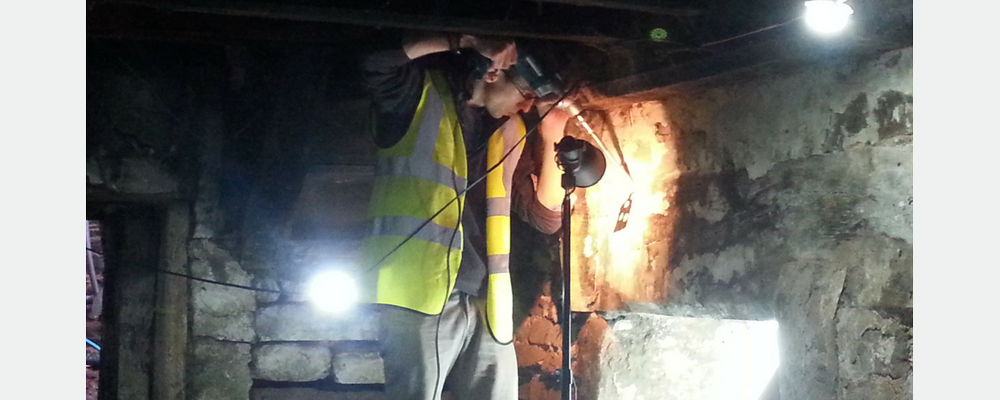
Ross Cook of Archaeodomus drilling a timber core from the rear kitchen bressummer at Llwyn Celyn.
Two of the Llwyn Celyn samples with intact sapwood and bark edge were identified as suitable for analysis. As this was the first time this experimental technique had been used on a hitherto undated building, the project team asked us to commission radiocarbon dates (or Carbon-14 analysis) on the same samples as independent verification. Radiocarbon analysis typically provides date spans too wide to add much to a building’s story, but this time we were happy to agree, thanks to a small amount unspent in our dendrochronology budget (part of our Heritage Lottery Fund grant on the project).
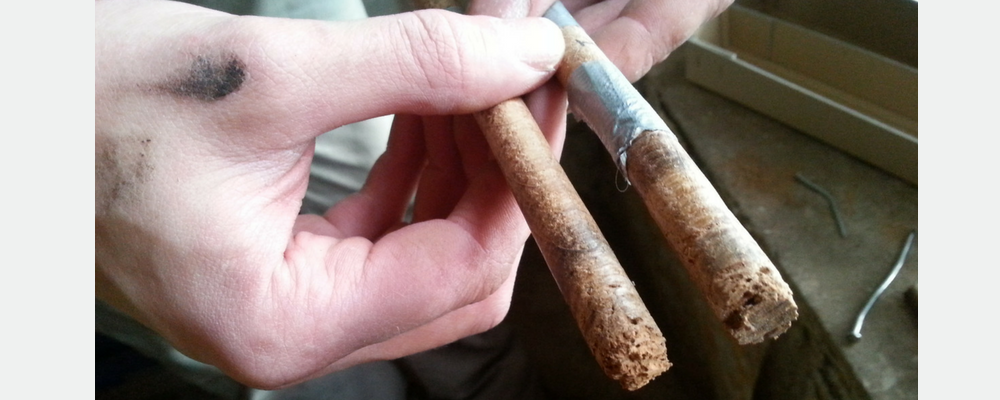
Simple timber cores like these can hold the clue to a building's age under conventional ring width analysis - but only if they include 50 or more rings and the bark edge. At Llwyn Celyn, we struggled to get enough rings in a single core because most of the timber was 'complacent' - it had grown too quickly.
Thrillingly, the oxygen isotope analysis has provided statistically robust results for felling dates of winter 1418/19 for a principle rafter in the solar roof, and winter 1420/21 for a joist at the service end of Llwyn Celyn. Both sampled timbers are unequivocally in their primary build positions. As further validation, the stable oxygen isotopes material from specific tree rings were then submitted for radiocarbon dating – which provided a very narrow date range of 1407-28 (with 95.4% probability).
Oak was used unseasoned in construction, so these results now allow us to say with confidence that the main house at Llwyn Celyn was built c1420, making it one of the oldest surviving domestic buildings in Wales and still further vindication of Landmark’s determination to save this important building.
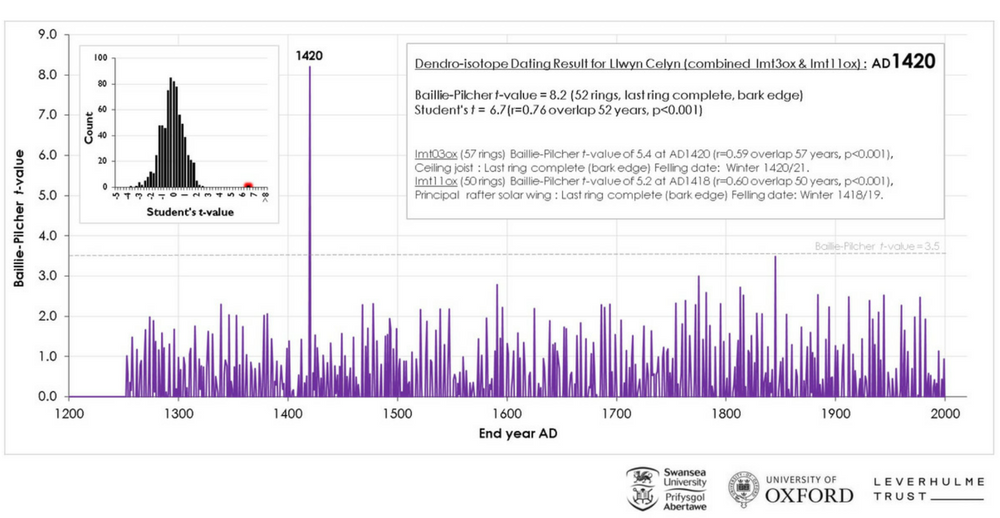 This graph reveals the confidence of the winter 1420 felling date against the wider oxygen-isotope database. © UK Oak Project.
This graph reveals the confidence of the winter 1420 felling date against the wider oxygen-isotope database. © UK Oak Project.
We also finally have a firm date to research in pursuit of the still unanswered question of ‘who built Llwyn Celyn and why?’ 1420 falls at the end of a period of huge disruption in Wales and the Marches, after the Black Death and further pestilence in the mid- to late-14th century, and then widespread devastation from 1400-1415 during Owain Glyndŵr’s rebellion.
Reconstruction followed on of course, but Llwyn Celyn was built intriguingly early in that process. Llanthony Priory, on whose lands its stands, is said to have been sacked by Glyndŵr in 1405-6. Documentary records are scarce for this period: we have commissioned further documentary research in the hope of finding out more. We’re also hoping that our project contingency budget might allow us to do some more oxygen isotope and radiocarbon analysis on other parts of the building, like the rear kitchen, chimney stack and even the outbuildings.
A hidden doorway
The second discovery is that of a blocked, pointed stone arch in the south wall of the high end of the hall. This was hidden between a combination of very early plaster that we were (and are) loathe to disturb, and crude 20th-century cement repairs. It was in removing the latter that the arch was revealed. Preliminary investigation by our project archaeologist Richard Morriss has proved that this was a doorway with a couple of steps leading up to it, and that it led through (rather than within) the wall, almost certainly to a narrow staircase up to the first floor chamber in the solar range. The stonework of the arch even bears extensive traces of yellow ochre limewash – our first discovery of an early 15th-century surface finish in the building.
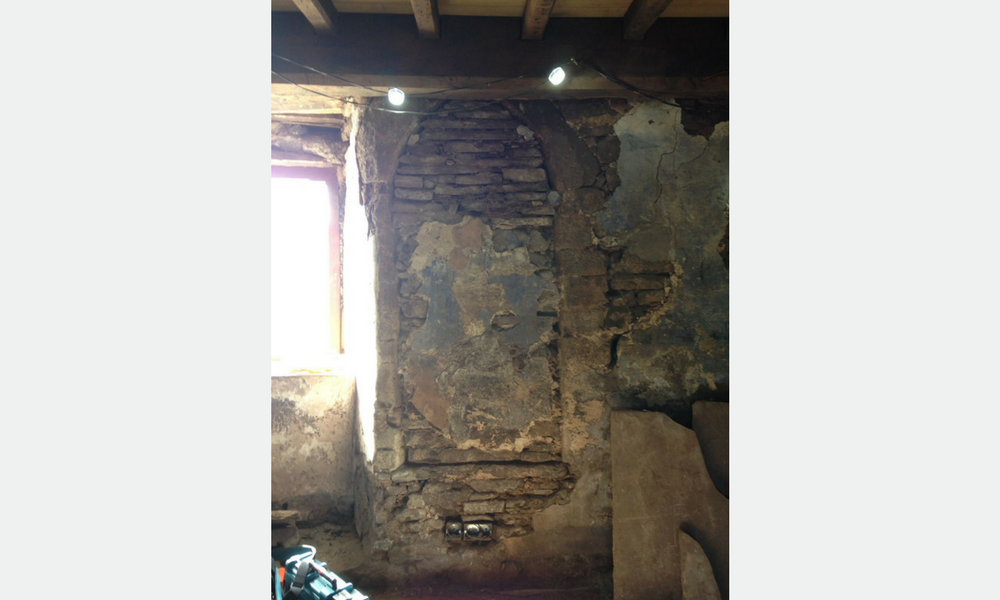 The pointed stone doorway at the high end of the hall at Llwyn Celyn.
The pointed stone doorway at the high end of the hall at Llwyn Celyn.
The presence of such a staircase underlines yet again that Llwyn Celyn was built for a person of very high status. We shall look out for signs of the footings of a lost external structure, whether stone or timber, as we excavate externally to install French drains in the probable area of the staircase, and also carefully explore the early internal plaster in the first floor chamber where the staircase would have emerged, to see if we can find traces of a corresponding doorway above. Llwyn Celyn may yet have more to reveal….
And who built Llwyn Celyn? Who had the wealth and the willpower so soon after a period of such devastation to impose their presence onto the mouth of the Llanthony Valley with a house of such presence, solidity and embellishment? We’ve speculated so far that it might have been a prior’s house (yet the priory was in disarray throughout the 15th century); or a rich yeoman farmer’s house (but who would have had the money so soon after the devastations of plague and Glywdŵr, when land returns plummeted with no one left to till the fields?) Or could it have been the steward of a rich Marcher lord, at a time when, according to historian R. R. Davies, ‘never had there been such an earthquake in the map of the lordships of Wales’?
My favourite theory so far came from a very knowledgeable member of the local history group we started five years ago now:
‘At the Battle of Agincourt in 1415, there was a Welsh archer called Daffyd Elisedd and he took prisoner a wealthy French knight, whom he ransomed for a princely sum. When he returned to his valley, Daffyd built the house he always dreamed of, complete with blank shields for the bearings he felt sure would come from his lord after his prowess at Agincourt…’
‘REALLY?’ said I (ever gullible).
‘Well, not that…’ he said, ‘but something like that….’
Llwyn Celyn: To Be Continued….
Update: January 2019
The oxygen isotope-informed dendrochronology was so successful that in summer 2018, we went back to the Swansea University team to see if they could help us with the other pressing questions about the building. The results they came back with were just as transformative to our understanding of Llwyn Celyn as the first set.
The technique delivered all over again. The new results gave us a date for Llwyn Celyn’s second big phase of work – the insertion of the ceiling and the chimney stack into the open hall, and the addition of the rear kitchen all took place with a few years of each other, in the 1690s. That date is interesting in itself in being very late for such changes, which typically happened decades earlier.
And thanks to the rest of our documentary research, we were able to pinpoint who was living on the farm in these years. In 1656, the lease was taken over by William Watkin(s), Gentleman, who already held other parcels of land in the valley. Under the unusually long, four-life copyhold leases common on the Llanthony estates, he had the confidence of knowing his family would be at Llwyn Celyn for a good long time. There is a sense of William Watkin establishing a dynasty in the changes he made at Llwyn Celyn, probably also dilapidated in the 1650s, and outdated in still being an open hall.
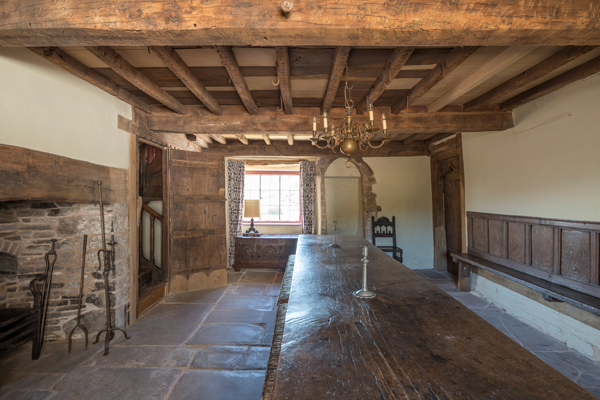 The hall at Llwyn Celyn, including its fixed bench
The hall at Llwyn Celyn, including its fixed bench
Watkin kept the archaic arrangement of a high end to his ceiled hall, installing the panelling behind the fixed bench. The isotope-informed dendro also told us that it was William who built the Beast House (today’s information room) with stalls for a dozen dairy cows – just at a time when dairy farming was particularly profitable. It also revealed that the magnificent Threshing Barn (today’s community centre), which we had dated to the early 18th-century, was in fact built soon after William arrived. The robust Cider House at the back of the house probably belonged to the same 1690s phase too.
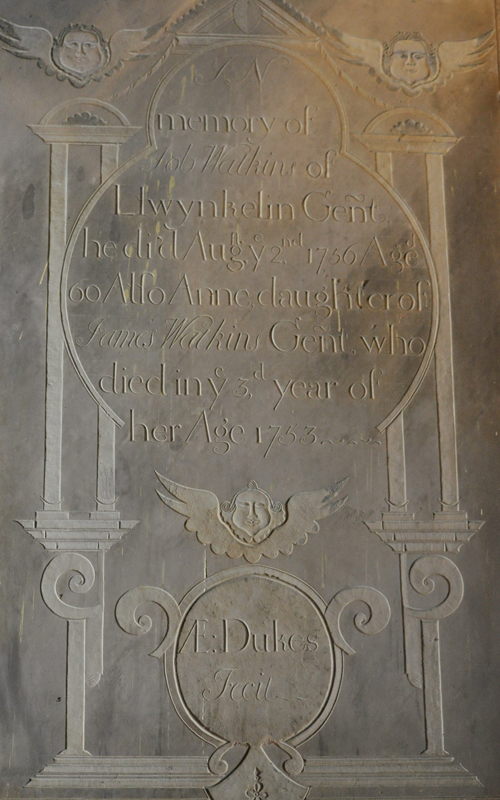 The fine memorial to ‘Job Watkins. Gent. Of Llwynkelin’ on the south wall of the nave of St Martin’s Church in Cwmyoy.
The fine memorial to ‘Job Watkins. Gent. Of Llwynkelin’ on the south wall of the nave of St Martin’s Church in Cwmyoy.
The Watkins were clever in their onward assignment of their lease and remained at Llwyn Celyn for more than a century. There is a fine memorial to Job Watkins, Gent., in Cwmyoy Church, who died in 1756. By now the landlord was Edward Harley and rents had risen steeply. Job’s son James couldn’t keep up. Encumbered by debt, in 1762 he surrendered his lease back to the estate in return for £20 in lieu of debt. That was the last of the Watkins family at Llwyn Celyn.
Once again, this fantastically accurate new dendro technique had provided dates for key phases of the building, on timber samples that had proved resistant to analysis by other means. It’s allowed us to piece together more of the story of the site, placing it in its wider historical context.
All building historians can have great hopes for the wider relevance of the UK Oak Project, driven by scientists from Swansea University’s Department of Geography and the Oxford Dendrochronology Laboratory. While the technique is still in its developmental phase at present, we are enormously grateful for their contribution to the Llwyn Celyn project.
Find out more about the Leverhulme Trust funded UK Oak Project: https://www.oak-research.co.uk/
Caroline Stanford, January 2019
